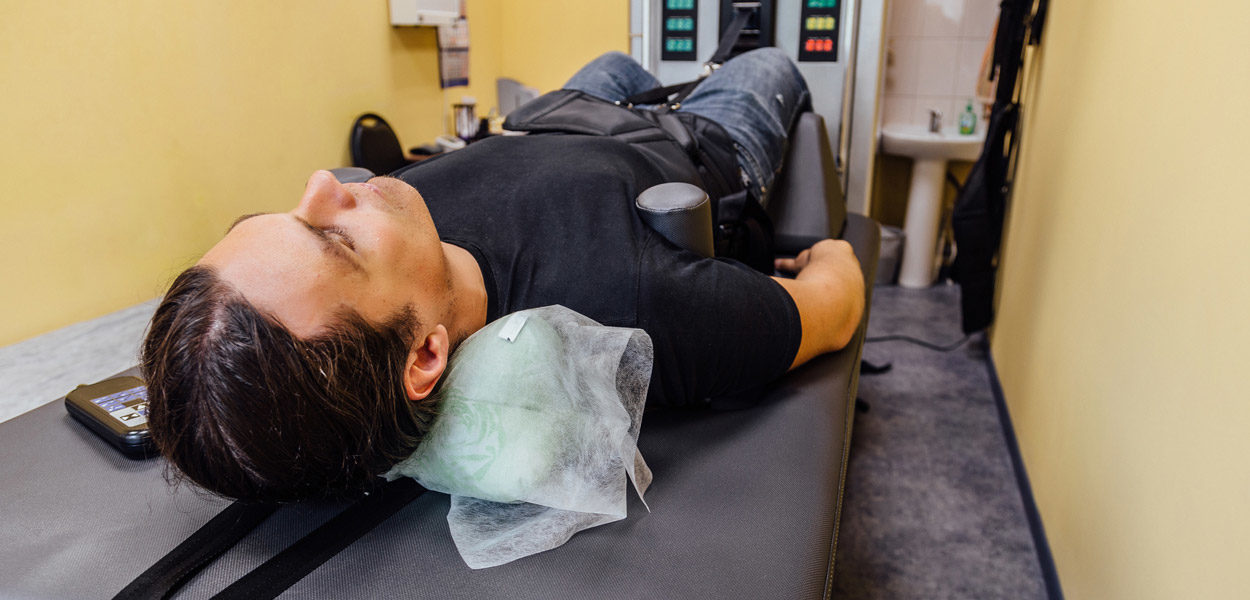section-1414e32

section-018cc4c
Spinal decompression therapy (DRX), also known as nonsurgical decompression therapy, involves using a traction table or similar motorized device to stretch the spine and relieve back pain and/or leg pain.
How Spinal Decompression Therapy Works
During therapy, the health care practitioner stretches and intermittently relaxes the spine in a controlled manner. This process creates:
- A negative intradiscal pressure to reposition the herniated or bulging disc
- Lower pressure in the disc will lead to an influx of healing nutrients and other substances into the disc
Common decompression devices include the VAX-D System, the SpinalAid System, and the DRX-9000 System.
Who is a Candidate for Spinal Decompression Therapy?
DRX therapy may be an effective treatment option for patients experiencing:
- Neck pain caused by a herniated, bulging or degenerated disc
- Sciatica (leg pain)
- Lower back pain
DRX is not recommended for patients who:
- Are pregnant
- Have broken vertebrae
- Have undergone spinal fusion
- Have an artificial disc, or other implants, in their spine
- Have undergone unsuccessful back surgery
- Have undergone multiple surgeries without improvement in symptoms
- Have abdominal aortic aneurysm
Patients diagnosed with the following conditions are also not good candidates for DRX:
- Osteoporosis (or osteopenia)
- Spinal stenosis
- Spondylolisthesis
- Spinal infection
- Spinal tumor
- Ankylosing spondylitis
DRX is not recommended for patients with a condition that may negatively affect the spine or patients taking a blood thinner medication.
section-24f3387


section-c8617d2
Risks of Spinal Decompression Therapy
The risks of DRX are very minimal. After one session, patients may experience a temporary dull and achy soreness as if they have worked out for the first time in a long time.
What to Expect During DRX
Patients will be instructed to lie on a motorized table in which the lower half can move. A harness will then be placed around the patient’s hips and attached to the lower part of the table near the feet. As the upper part of the table remains in a fixed position, the lower part will slide back and forth to provide traction and relaxation. The medical practitioner will use a computer to control the table and customize treatment to each patient’s unique needs.
Some devices require the patient to lay face down, while other devices will have the patient lying on their back, face up.
Patients typically undergo a series of 15 to 30 treatments, with each treatment lasting 30 to 45 minutes, over a four- to six-week period. DRX sessions may also involve electrical stimulation, ultrasound, and cold and/or heat therapy.
Why Patients Should Consider Spinal Decompression Therapy
Spinal decompression is the only treatment method that has been shown to achieve negative pressure to as low as -110 mm Hg3 within the injured disc. The body’s natural proprioceptor response to a pull on the spine is to tighten muscles surrounding the vertebrae and discs to prevent injury. However, spinal decompression bypasses this response by creating a slow pull that relaxes the back over an extended period of time, enabling the discs to be repositioned without any tension and without triggering the muscle guarding and spasms.
